A few weeks ago I was wandering around a part of the countryside that I know very well -the Chilterns- on a route I’ve walked dozens of times (Chorleywood to Chesham), when I spotted Jesus.
Not the historical or spiritual figurehead, he of a million paintings, cards, and stained-glass windows: Jesus the Original God-Botherer (OGB), Jesus the martyr, dying on a cross purportedly for our sins (still not sure why he needed to do that). This was not a supernatural or otherworldly visitation, it was very much part of this earthly realm: 33 stones shaped into that provocative name. For it provokes something in all of us, whether positive or negative: JESUS. There he/it was on, announcing his name from the earth beneath my feet.
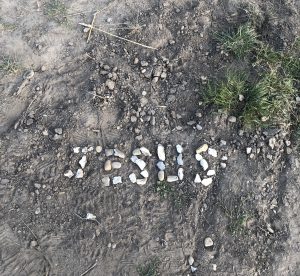
I paused for a moment to take it in, enjoying as much as anything else the pleasure of finding those familiar man-made letters out here in the predominantly unlettered countryside; enjoying the built-in ephemerality of this construction, and wondering about the inner life of the person who had gathered and made this modest, but possibly also agenda-led, piece of land art.
The small valley in which the work was situated has always gladdened my heart. Every time I emerge from the descent through the woods into the expanse of this space it feels like a kind of home-coming. For some reason, largely due to juxtaposition, this particular patch of ground feels grand-canyonesque when you step into it, even though it probably only stretches 600 yards in either direction. Which is also to say, using the language of psychology, that some kind of positive priming was already at work before those stones “spoke” to me.
A few minutes later, I came across another piece, presumably by the same artist, this time in slightly larger stones sunk slightly in the grass, and arranged with even greater finesse:
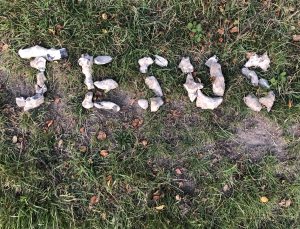
Please take a moment to admire the beautiful interlocking bottom of the U, as if the two stones that contribute to the formation of this letter were just waiting to be intertwined with each other in a chiasm of smooth hard flesh. And what about that knurled , almost flame-shaped stone which makes up the top of the second S? A stone that also looks a bit like the head of a wolf or one of its canine cousins?
This second betokening of Jesus was a much more chunky, shout-it-from-the-rooftops version of the first. So I stood before it, as one might stand before a piece of sculpture in a gallery, not really thinking of much, but enjoying its resonances in a slightly ambivalent way, as well as its temporary presence in the landscape that I was passing through. I took a picture of it on my phone and moved on.
Heading in the direction of Hill Farm, I came across the third Jesus. This one on a bench. One of those very simple countryside benches made of a single slab of wood held up about two feet off the ground by two blocks on either end.
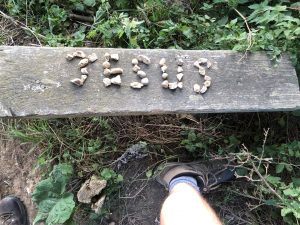
Perhaps because this was the third piece of land art I’d discovered in less than half an hour, I walked around the stones this time, taking them in from a few different angles.
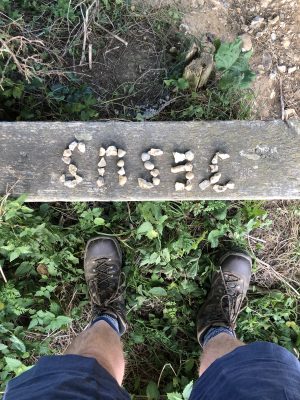
Seen from this vantage point, turned upside down, the stones, with a small nudge here and there, might appear quite happy to shift into a slightly different, but not wholly unrelated pattern.
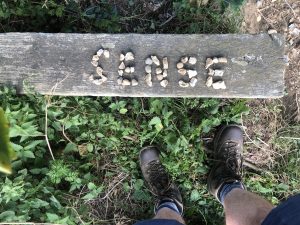
Hopefully this wasn’t too deliberate a desecration of the original artist’s work. Was I not making SENSE of JESUS for myself, albeit by moving the original letters around rather than setting up my own word(s) in a separate, quasi-critical relationship to the first word?
This kind of reconfiguring comes very naturally to us human animals, entranced as we sometimes still can be by the symbolic layers of the nonhuman world around us. Is not paint just pigment moved around: suspended by us in a binder such as acrylic, polyurethane, or oils, mobilised by further diluents, and then transferred by brush, finger, or another mark-maker onto the grey or white weave of a canvas? Similarly, but even more elementally, pencils leave their graphite trails when applied to a slightly abrasive surface like paper.
I decided to repeat this game, by placing myself on the other side of the word so that my new perspective once again shifted SENSE into a kind of dissolving non-sense (i.e. ƎSNƎS) before the stones finally settled into the next configuration (below):
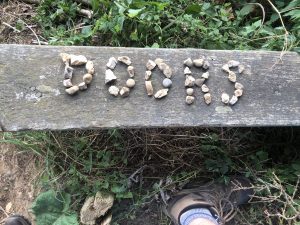
No one but the stones and I were cognizant of this edgy little metamorphosis from JESUS (or S∩SƎſ) to SENSE and ƎSNƎS, and finally to DOORS. What we (myself, the stones, the landscape) bore witness to, was in some way the bony skeleton of a poem: a mythical or historical figure’s name, the SENSE we make of it, which also acts as a DOOR to a new realm of perception or understanding, through which we might pass and perhaps in some way re-embody ourselves.
I say no-one else witnessed this, but Max was of course there, taking in this curious pushing around of the material of his world (rocks, stones, grass, dirt) into configurations that were possibly as dumb to him as words themselves. Who knows what a dog hears when we try and interact with them through our symbolic language.
There was also another man, a dog-walker, who traipsed past as I was looking at the third JESUS and asked me if I had made the stone composition, the question igniting a flickering of shame, replaced quickly by relief when I was able to say no I hadn’t. Perhaps for this reason, I then somewhat akwardly tried to explain to him (just in case he was aligned to JESUS in ways I was not) that I quite liked the word, shaped as it was, but didn’t really know what to “make” of it, or “do” with it. He didn’t either, so turned his attention back to his dog and walked on.
—
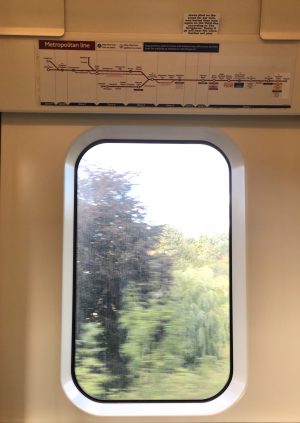 The stones continued to rattle around in my head for a few days after that, until I realised what it was about them that I found so affecting.
The stones continued to rattle around in my head for a few days after that, until I realised what it was about them that I found so affecting.
For I had clearly been moved by those three configurations of Jesus, even if not in the way intended by their maker. I suspect the Stone Gatherer might have wanted his or her work to prod my conscience or “soul” in the ways of rudimentary marketing, evangelizing me into rethinking my relationship with churches and biblical verse. No longer seeing them as calming, restorative places or mythopoetic literature, but rather the literal manifestation of a patriarchal deity and his specific purposes for our lives (mainly, as far as I can tell, serving Him).
On the Metropolitan line an hour earlier, a less charming, more bombastic version of this call-for-contemplation had caught my eye in a postcard that combined the usual culpability maneuver with a line from Hebrews 3:15 (see accompanying photograph).
The language of the card was very familiar. It’s message something along the lines of:
“Yo, sinners! Jesus died on the cross for us, and then instead of hanging out in heaven with his Pa, returned to earth so that we might know it was not just sleight-of-hand or mouth on his part, but THE REAL DEAL. So here’s a (Christ-ian) invitation to worship him [followed by the line from the Bible]: Today if you will hear his voice, harden not your hearts, as in the provocation.”
Unlike the stone configurations, this was just semantic litter, a man-made imposition slotted adjacent to a view through the tube window that had, to my eyes, more “Jesus” in it, animistically speaking (trees blurring past in glorious shades of green and burgundy), than a thousand instances of printed religious propaganda.
The reason I found the Jesus signs affecting and moving but the tube postcard mere debris, was I think due to the fact that the former held within it “the spell of the sensuous”, whereas the latter was merely another piece of human advertising.
—
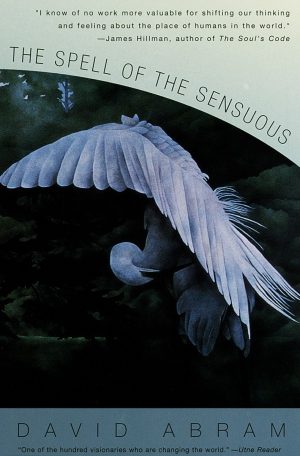 In David Abram’s life-changing book The Spell of The Sensuous, Abram shows us in searing prose how our estrangement from the world around us, not just from each other, but from our nonhuman environment can in part be traced back to the invention of writing, and the ways in which early pictographic and ideographic writing systems were gradually replaced by an entirely abstract alphabet, by phonetic scripts that no longer held any associations for us with our natural environment.
In David Abram’s life-changing book The Spell of The Sensuous, Abram shows us in searing prose how our estrangement from the world around us, not just from each other, but from our nonhuman environment can in part be traced back to the invention of writing, and the ways in which early pictographic and ideographic writing systems were gradually replaced by an entirely abstract alphabet, by phonetic scripts that no longer held any associations for us with our natural environment.
Although we make this claim for our species, we were not the first to “write” ourselves onto our environment:
“The earthly terrain in which we find ourselves, and upon which we depend for all our nourishment, is shot through with suggestive scrawls and traces, from the sinuous calligraphy of rivers winding across the land, inscribing arroyos and canyons into the parched earth of the desert, to the black slash burned by lightning into the trunk of an old elm. The swooping flight of birds is a kind of cursive script written on the wind; it is this script that was studied by the ancient “augurs,” who could read therein the course of the future. Leaf-miner insects make strange hieroglyphic tabloids of the leaves they consume. Wolves urinate on specific stumps and stones to mark off their territory. And today you read these printed words as tribal hunters once read the tracks of deer, moose, and bear printed in the soil of the forest floor. ”
By extension, “our first writing, clearly, was our own tracks, our footprints, our handprints in mud or ash pressed upon the rock. Later, perhaps, we found that by copying the distinctive prints and scratches made by other animals we could gain a new power; here was a method of identifying with the other animal, taking on its expressive magic in order to learn of its whereabouts, to draw it near, to make it appear.”
A trace of this magical thinking still remains in the Jesus Stones. But unfortunately, as our letters became untethered from the things they had first pictured, so we too lost touch with the more-than-human world, to a point where today if we get to experience the nonhuman environment, it is mainly through reading about it via our denatured alphabet, or looking at flattened versions of it on our screens.
Abrams traces this state of affairs back to Socrates’ assertion in Plato’s Phaedrus, one of the founding texts of our modern civilization that he would rather stay in the city than go for a walk in the countryside: “I’m a lover of learning, and trees and open country won’t teach me anything, whereas men in the town do.”
In that simple, but dualistic declaration, we as a species step away from millions of years of interconnection and profound affiliation with our natural world and all the other species living within it, to assert that we are now super-special Great Apes, with a newly-invented abstract writing system, allowing us to stand separate, as well as superior to every other natural phenomena on this planet. You want to know where our desecration and annihilation of the planet and everything nonhuman on it begins? It begins here.
“Socrates,” writes Abram, “may be recognised as the hinge on which the sensuous mimetic, profoundly embodied style of consciousness proper to orality, gave way to the more detached, abstract mode of thinking engendered by alphabetic literacy.” Plato, just like the alphabet itself, is not interested in specific rivers, rocks, trees and stones, as your or I might be when walking from Chorleywood to Chesham, but rather the pure Idea (eidos) or unchanging essence of The River, The Rock, The stone, The Truth.
Two and a half thousand years later, Big Data has a similar view of human animals and their world. We all now hover in this strangely timeless, dimensionless, virtual existence of abstract worlds, entirely mediated by letters and numbers. We are all to some extent, and often to a very great extent, profoundly estranged and alienated from the world around us, as well as ourselves. Thought, our closest ally, is perceived linguistically too, as a series of word-encoded permutations drifting through the mind like Very Important Clouds.
“This new, seemingly autonomous, reflective awareness is called, by Socrates, the psychê, a term he thus twists from its earlier, Homeric significance as the invisible breath that animates the living body and that remains, as kind of wraith or ghost, after the body’s death. (The term psychê was derived from an older Greek term, psychein, which meant “to breathe” or “to blow”.) For Plato, as for Socrates, the psychê is now that aspect of oneself that is refined and strengthened by turning away from the ordinary sensory world in order to contemplate the intelligible Ideas, the pure and eternal forms that, alone, truly exist. The Socratic-Platonic psychê, in other words, is none other than the literate intellect, that part of the self that is born and strengthened in relation to the written letters.”
And yet.
And yet, all is not lost. For as Abram suggests, the deep history of our abstract writing systems still points, even in a very withered state, to the sensuous, embodied forms of animism that are deeply connected to our creaturely experience.
“As a Zuñi elder focuses her eyes upon a cactus and hears the cactus begin to speak, so we focus our eyes upon these printed marks and immediately hear voices. We hear spoken words, witness strange scenes or visions, even experience other lives. As nonhuman animals, plants, and even “inanimate” rivers once spoke to our tribal ancestors, so the “inert” letters on the page now speak to us! This is a form of animism that we take for granted, but it is animism nonetheless—as mysterious as a talking stone.”
If you take a moment to think about it, this is utterly magical. Hence the “spell” of the sensuous. “Perhaps the most succinct evidence for the potent magic of written letters,” writes Abram, is to be found in the ambiguous meaning of that common English word:
“As the roman alphabet spread through oral Europe, the Old English word “spell,” which had meant simply to recite a story or tale, took on the new double meaning: on the one hand, it now meant to arrange, in the proper order, the written letters that constitute the name of a thing or a person; on the other, it signified a magic formula or charm. Yet these two meanings were not nearly as distinct as they have come to seem to us today. For to assemble the letters that make up the name of a thing, in the correct order, was precisely to effect a magic, to establish a new kind of influence over that entity, to summon it forth! To spell, to correctly arrange the letters to form a name or a phrase, seemed thus at the same time to cast a spell, to exert a new and lasting power over the things spelled. Yet we can now realize that to learn to spell was also, and more profoundly, to step under the influence of the written letters ourselves, to cast a spell upon our own senses. It was to exchange the wild and multiplicitous magic of an intelligent natural world for the more concentrated and refined magic of the written word.”
WOW.
This seems like incredibly rich territory for making art, but equally for learning to live again through every pore of our body as we once did, but very rarely do now. To live within and in the embrace of the natural world, as opposed to one (or a million) steps removed from it with our word-focused, abstract-making eyes and minds.
What Abram’s book makes me want to do is spell a few things out to myself, to other passing human animals, but equally to the nonhuman, animate world that surrounds us. But not on a screen as I am doing here. No one reads or cares about screenwords anymore. And not through paints or pencils, either. Rather, I think I’m going to follow in the footsteps of the Jesus Artist, and other Environmental Artists like him/her, using materials found on-site, but focusing mainly on words. Because words, for me, and for others (I’m thinking here of Hughes’ Thought Fox, but maybe poets in general) point to experience in a very real and alive way. Especially so, perhaps, when they are formed by and through living materials?
If and when I do some of this, I shall write of the walks where the spell-making occurs, including images of “spells” cast here, and in an Instagram account called @spellofthesensuous.
